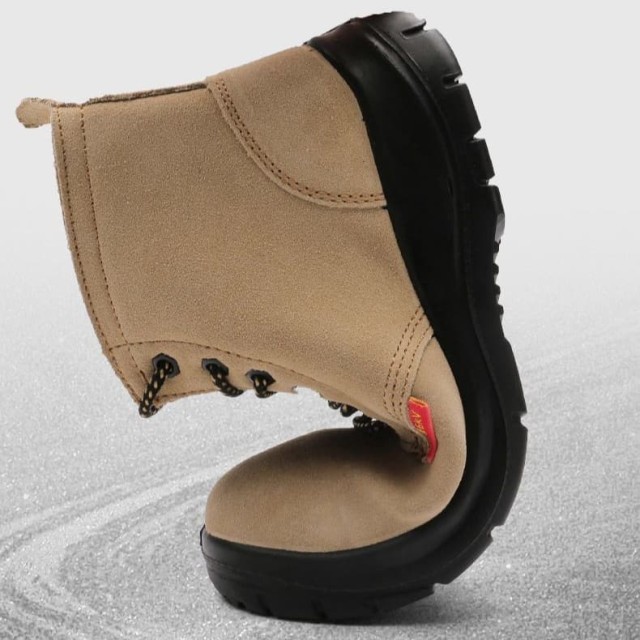For decades, steel toe shoes have been the default choice for workplace safety—but their drawbacks (weight, temperature sensitivity, and metal detection issues) create real challenges. Modern alternatives like composite and alloy toes now offer equal protection with game-changing comfort. Here’s how to match the right technology to your job’s demands.
Understanding Steel Toe Shoe Drawbacks
While steel toes meet rigorous safety standards, their limitations affect performance and comfort in specific scenarios. Recognizing these pain points is the first step to finding better solutions.
Weight vs. Protection: Breaking Down the Trade-Off
Steel toe caps add substantial weight—often over a pound per shoe—which strains legs and feet during long shifts. Research shows that every extra pound on your feet equates to carrying five pounds on your back. For roles requiring mobility (e.g., warehouse work or construction), lighter materials like carbon fiber or aluminum can provide equivalent impact resistance without the fatigue.
Metal Detection Interference in Sensitive Environments
Airports, secure facilities, and some manufacturing plants use metal detectors that steel toes trigger. Composite materials (Kevlar, fiberglass) offer a detector-friendly alternative while meeting ASTM F2413 standards for compression and impact resistance.
Ergonomic Challenges in Long Shifts
Traditional steel toe boots often lack arch support and cushioning. Workers report numbness and joint pain after 8+ hours of wear. Modern designs integrate:
- Contoured footbeds with shock absorption
- Flexible toe boxes that reduce pressure points
Temperature Extremes and Material Limitations
Steel conducts heat and cold efficiently, making it problematic in:
- Freezers: Toe caps become uncomfortably cold
-
Foundries: Heat transfer risks burns
Composite materials insulate against temperature transfer, while aluminum toes (lighter than steel but still conductive) suit moderate climates.
Practical Solutions for Common Pain Points
Innovations in materials and design now address steel toe shortcomings without compromising safety.
Composite Toe Technology: A Lighter, Detector-Friendly Option
Made from layered fibers (carbon fiber, Kevlar), composite toes:
- Weigh 30–50% less than steel
- Won’t set off metal detectors
- Resist temperatures from -40°F to 500°F
Limitation: They may crack under extreme, direct impacts and require replacement if damaged.
Innovations in Cushioning and Arch Support
Look for features like:
- Dual-density midsoles: Cushion heels while supporting arches
- Metatarsal guards: Protect the foot’s upper surface without added bulk
- Breathable liners: Reduce sweat and friction
Climate-Adaptive Safety Footwear Designs
- Cold environments: Insulated composite toes with thermal liners
- High-heat areas: Heat-reflective outer materials paired with non-conductive toes
- Electrical work: Non-metallic composites prevent conductivity risks
Industry-Specific Recommendations
Construction and Manufacturing Use Cases
- Best for impact protection: Steel or alloy toes for heavy machinery zones
- Best for mobility: Composite toes with slip-resistant soles for scaffold work
Cold Storage Facilities and Electrical Work Scenarios
- Freezer warehouses: Composite toes with thermal insulation and waterproofing
- Electricians: Non-conductive fiberglass toes and static-dissipative soles
Upgrade Your Safety Footwear with 3515
Whether you’re a distributor sourcing bulk orders or a brand owner seeking custom designs, 3515’s expertise ensures footwear that combines protection with ergonomic innovation. Let’s build solutions tailored to your workforce’s needs—because safety shouldn’t come at the cost of comfort.
Related Products
- Customizable Anti-Smash Safety Boots for Wholesale & Private Label Manufacturing
- Wholesale Mesh Steel Toe Safety Shoes with Dial Closure Factory Production
- Safety Footwear Wholesale Manufacturer for Custom OEM/ODM Production
- Wholesale Safety Footwear Manufacturer for Bulk & Custom OEM Orders
- Athletic Safety Shoes with Dial Closure & Steel Toe for Wholesale & Custom Manufacturing
Related Articles
- Steel-Toe Boot Safety: Separating Fact from Fiction
- Matching Men’s Work Shoe Safety Technologies to Workplace Hazards
- How Steel Toe Shoes Prevent Injuries: The Science Behind Workplace Safety
- How to Choose Steel-Toe Boots: Matching Safety Standards to Your Job Demands
- Steel-Toe vs. Composite-Toe Boots: How to Choose the Right Safety Footwear for Your Job



















